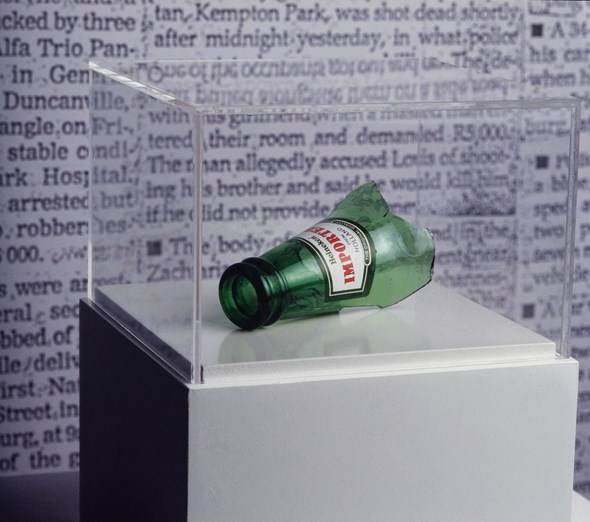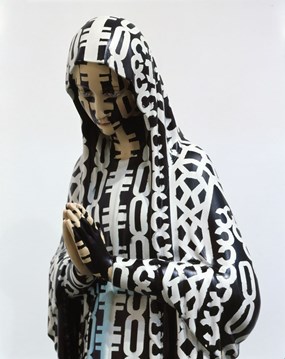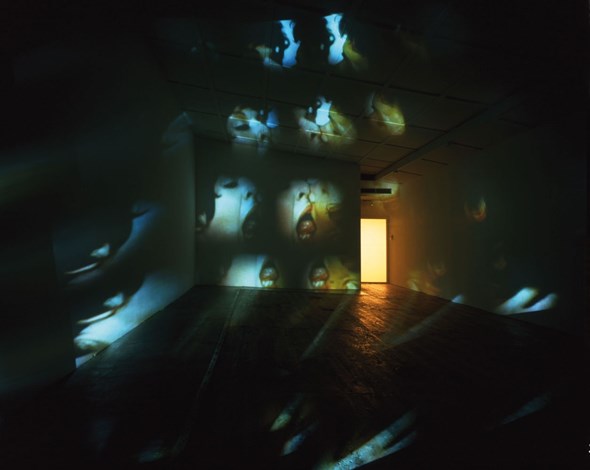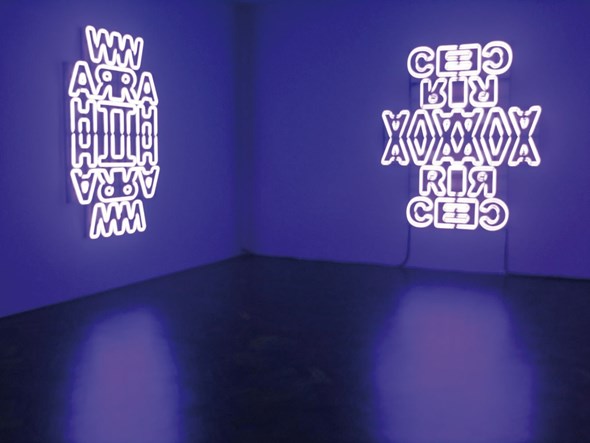
By Ines Gebetsroither
We assume that life produces the autobiography as an act produces its consequences, but can we not suggest, with equal justice, that the autobiographical project may itself produce and determine the life[…]? Paul de Man, Autobiography as De-Facement
Revolutionaries in the classical sense of the word are criminals, who set themselves up against society and turn the rules upside down. The connection between revolution and the law is thus clear. But let’s assume that revolutionaries are not outside the law, that there is in fact no contradiction between revolution and law and that what the law depends on, namely the way it is formulated, is in a state of permanent and unpredictable change.1 Let us assume, in other words, that the revolution takes place every day. Its principle is the inversion and reformulation of rules. Its methods are camouflage, coding, re-interpretation. It would therefore be no coincidence that K.O.lab alias Kendell Geers in the neon-installation noitu(love)r (2002) connects the terms »Revolution« and »Love« in a cryptogram. In this case, love is decoded as the inherent reverse side of revolution.
Language is a self-replicating virus that can only be destroyed by a stronger, more resilient virus. Kendell Geers, The Affluence and the Effluence
Kendell Geers’ strategy is clustering, but he doesn’t practice it as in innocent sequencing of casual (chance) associations, but rather it makes both offensive and controlled use of the border between legitimacy and illegality; it steals, exploits and subverts, without remorse; it has no obvious fear of bad taste, banality or sexism; it embraces violence no less than risk, real danger and pornography. But what is really going on in this often brutal-seeming game of reference and interference?
A thematically central part of his work is Geers himself, his identity as an artist, as a »TERROREALIST«2 , as born »guilty« (as a white in South Africa). He changed his own date of birth to May 1968, the month in which the following events occurred, all referred to in his work T.W. (C.V.): »Marcel Duchamp dies«, »Martin Luther King is murdered«, »protests at the Venice Biennale – last participation of South Africa until 1993«, »riots in Paris«, »South Africa excluded from the United Nations«, »Andy Warhol shot at by Valerie Solanas«. T.W. (C.V.) is a (his) »artist biography« in the form of a list (and ergo compression) of historical, art-historical and personal events that begins with 6 April 1652, when Jan van Riebeek declared the Cape of Good Hope to be a Dutch colony – the event that is fundamental to Geers’ contradictory, linguistically expressed oxymoronic existence as a »White African« or a »privileged inhabitant of the Third World«. T.W. (C.V.) is, however, at the same time a self-portrait of a very special kind: a representation of the self as the sum of references to his own life story and art and the violent acts of world history. A crypto-self-portrait, whose title also needs to be decoded: Title Withheld (Curriculum Vitae). Geers’ well-known Self-Portrait, 1995 (Original destroyed on flight TW800), which consists of a broken-off neck from a Heineken bottle, is also certainly explicit in its title and yet is still a cipher in the form of an object, which can be deciphered, on the one hand, from the text on the label – »Imported from Holland«, another reference to the origins of his Boer ancestors – and, on the other hand, from the narrative element that can be read from it: the shattered bottle as a code for the crude act of a rebel, which stands perhaps less for the person of the artist than for his not-so-harmless self-perception as artist. (It is no coincidence that Geers writes in his text I, TERROREALIST, ironically, that it is enough to knock off the neck of an in-flight champagne or red wine bottle to be able to use it to cut the throats of a dozen or more passengers, if one’s nail file or nail scissors have been confiscated at the airport.)
Once more back to the rhetoric of »Title Withheld«, which Geers used instead of a title for several years or else used it in conjunction with a designation (in brackets). Unlike the simple gesture of refusal in »No Title«, »Title Withheld« suggests that there is or could be a title for the work, but that it has been replaced by a cipher or a gap, a reference to something else. But the question is: reference to what? Is this, as Derrida would say, not at all »absence in the place of presence«, but rather »a trace that replaces a presence that was never present, an origin with which nothing began«?3 Is it a sly hint from Geer of his artistic method in general, at whose centre stands the merciless exploitation of innumerable references, and where the idea of a »correct« original no longer exists, because it is assumed that all cultural property is in any case merely plagiarism?
It is upon this process of naming in order to control, that the success of the brave new world largely depends. This process of passive consumption and resulting recoding of reality results in a cultural effluence in the same way that the raw materials from the production process end up polluting our natural resources. In the same way that the survival of the planet today depends on cutting back on the harmful emissions and in recycling waste, so too must the cultural crap being fed to us be recycled and distilled. Kendell Geers, The Affluence and the Effluence
His Title Withheld (Stolen Idea) (1995) is an obvious paraphrase of Gabriel Orozco’s Yielding Stone (1992), a big ball of plasticene, which Orozco rolled through the streets until it had gathered so much street dirt that it weighed exactly the same as the artist. In the »Title«, which again consisted of an absence and a »declaration«, Kendell Geers describes the work as a theft, a »stolen idea«, in an ironic (one might say cynical) hint of what it is (in this way Geers re-criminalises an actually illegitimate act, which, however, is legitimate within the protected sphere of art and is, indeed, more than customary, not only under the key-word appropriation) – but without excluding other, more deeply concealed relationships: such as the question why this work in particular, which is in turn and doubtless not only in the form of weight-equivalence, in itself a kind of crypto-self-portrait. Geers quotes the Mexican Orozco, whose work makes use of various strategies of appropriation and decontextualisation, indeed more than once. For example, Fuckface (2005), one of his most recent works, which give up the ambiguity of »Title Withheld« and are often extremely explicit in their titles, is a quotation from Orozco’s Black Kites [a kind of bird that helps itself to human waste on rubbish tips or streets] of 1997, skulls painted with checks. Geers replaces this pattern with another, a textual pattern that consists of the repetition and reversals of the word »FUCK« but which rather looks like a pattern of chains or of barbed wire4 , which, by the way, covers over or constitutes many of his most recent works, including the sprayed Madonna figure Holyfuckingvirgin (2006) or the neon work Fucking (Black) Heart (2006).
In point of fact, Kendell Geers’ cluster is several degrees rougher and more direct than the sometimes very poetic reference system of Gabriel Orozco, even though the references usually still run on, under the obvious surface. It is not formed around the metaphor of someone picking something out of the waste of modern civilisation, paying attention to what is normally neglected. Geers’ cluster is made up of hardcore elements. It is not interested in the poor, the victims but for the perpetration. That the artist is identical with the perpetrator may be taken for granted – his traces (once they are revealed) go through his entire work. Mondo Kane (2002), for example, a concrete block with green shards of glass stuck in it – an object almost characterised by a minimal aesthetic, were it not for the sharp, dangerous-looking shards. Here, yet again, the title has something to add: a merging of »Mondo Cane« and »Citizen Kane«, two film references that one needs to examine more closely. The Mondo films, of which Mondo Cane is the best known, are shockumentaries from the 1960s and 1970s, which mainly documented violence (and the violent), serial murderers, sadists or torturers, and which were censored or banned in some countries. And Orson Welles’ Citizen Kane, whose plot no doubt also reveals something about the artist/»perpetrator« identity of Kendell Geers – after all, it is characterised by a fragmentary, non-linear structure and shows the biography of the protagonist Kane only in patches, which the viewer has to put together like a puzzle. Precisely that (the act of splitting) can be seen several times in the film as a metaphor: for example a jigsaw puzzle is laid out or a nurse is reflected in a broken snow globe. It is not far from there to the disco ball, which occurs in Geers’ work several times, not as a leitmotif, certainly, like the shard of glass, but nevertheless woven through the oeuvre: in Post Pop Fucking Fuck (2006) as a slick object sprayed with the »fuck pattern«, making the title tautological. Or, earlier, in »Deep Throat« (2002), where it is used as a projection medium through which defining scenes from the pornographic film of the same name of 1972 are projected, splintered, onto the wall. Again the continuing narrative triggers itself: Deep Throat – the soon banned scandalous porno about a woman whose clitoris was in her throat – was a Mafia business, which is why its main actor, Harry Reems, as a peasant victim, was convicted for conspiring against the state once the FBI had been called in. Linda Lovelace, who plays the female lead, spoke later in public talks about the violence and fear she suffered during the filming. In the year Geers’ work was made, her body was totally shattered in a motor accident.
Geers uses pornography or prostitution emblematically in the form of hardcore quotes, particularly also in drawings (ink on paper) or the muralLa Sainte Vièrge (2005) , where Geers combines pornographic images of masturbating women with a quote from Picabia (La Sainte Vièrge, 1920, a spot of paint) and adds real condoms and broken bottles on the ground. In the installation Truth or Dare (Jan Hoet) (2001), again, the voice of a dominatrix is heard – allegedly during a visit from Jan Hoet. The work consists of a pile of megaphones, of the kind used by the police or demonstrators, from which the sound emerges. In this crypto-portrait of the curator Jan Hoet many other aspects are also reflected, which are explicitly or implicitly parts of Geers’ cluster system: the music documentary In Bed With Madonna, which ran in America under the titleTruth or Dare, is one of them, with Madonna’s famous masturbation scene, which was also a part of her Blonde Ambition Tour, for which she was almost arrested by the police in Toronto; and in which the game of daring Truth or Dare? is played and Madonna has to demonstrate oral sex on a bottle ...
DYNAMICS OF CRYPTOGRAPHY
The series, Seven Deadly Sins (2006), seven neon signs each of which stands for one of the seven deadly sins, has the concealed term »SLUT« as an ambigram of »LUST« reflected on two axes, the word DIE in the presentation of »PRIDE«, and the words »WAR« and »RAW« in the presentation of »WRATH«. The series makes reference to Bruce Nauman’s neon works, which are also based on puns, such as Raw-War (1970), a palindrome, or Violins Violence Silence<k>, a multi-reflection or overlapping of the (peaceful) terms »Violins« and »Silence with »Violence«. And yet the subtext delivered by Geers in his works and in his texts is something different. It is the subtext of a revolutionary, who uses the dynamics of the secret to infiltrate the world with his ideas.
1 This is the suggestion of Paul de Man. Compare Jacques Derrida: Mémoires. For Paul de Man. Ed. by Peter Engelmann. Vienna: Edition Passagen, 2005, p. 189.
2 This (I, TERROREALIST) is the title of one of his texts. See www.kendell-geers.net.
3 Jacques Derrida: Die Schrift und die Differenz. Frankfurt/Main: Suhrkamp 1976, p. 444.
4 Barbed wire is one component in many installations of Geers.
Translated by Nelson Wattie
INES GEBETSROITHER is an editor of spike and lives in Vienna.
KENDELL GEERS, born in 1968 in Johannesburg (South Africa), lives in Brussels.
Represented by STEPHEN FRIEDMAN GALLERY, London; GALLERIA CONTINUA, San Gimignano/Beijing; GALERIE RODOLPHE JANSSEN, Brüssel; GOODMAN GALLERY, Johannesburg/Kapstadt; YVON LAMBERT, Paris



